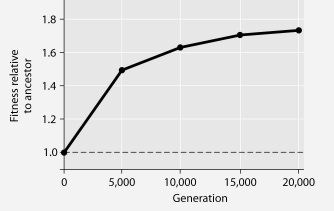The following questions refer to Figure 27.1.
In this eight-year experiment, 12 populations of E. coli, each begun from a single cell, were grown in low-glucose conditions for 20,000 generations. Each culture was introduced to fresh growth medium every 24 hours. Occasionally, samples were removed from the populations, and their fitness in low-glucose conditions was tested against that of members sampled from the ancestral (common ancestor) E. coli population.

Figure 27.1
-Which term best describes what has occurred among the experimental populations of cells over this eight-year period?
Definitions:
Intraepithelial Lesion
A term describing early changes in the cells of the skin and some mucous membranes that may develop into cancer, usually found in the context of cervical cancer screening.
Epithelial Cell Abnormalities
Irregularities in the cells lining the surfaces of organs and structures in the body, which can indicate disease or cancer.
Gynecology
A branch of medicine that focuses on the health and diseases of the female reproductive system, as well as related issues in other bodily systems.
Lamaze
A program or method of managing labor during birth.
Q3: When male horses (stallions)and female donkeys (jennets)mate,they
Q9: A dissection of the interior of this
Q21: What is true of the clade Ecdysozoa?<br>A)It
Q34: If a multicellular animal lacks true tissues,then
Q39: A fruit fly population has a gene
Q50: How do transposable elements and short tandem
Q52: What is true of macroevolution?<br>A)It is the
Q59: Biologists have noted that lichen structure differs
Q72: On the basis of their morphologies,how might
Q74: In the figure above,the process labelled "6"